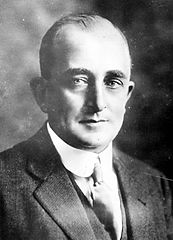Arturo Araujo
| ||
 | ||
| Data i miejsce urodzenia | 1878 Caja Seca | |
| Data i miejsce śmierci | 1967 San Salvador | |
| Prezydent Salwadoru | ||
| Okres | od marca 1931 do grudnia 1931 | |
| Przynależność polityczna | Partia Pracy | |
| Wiceprezydent | Maximiliano Hernández Martínez | |
| Poprzednik | Pío Romero Bosque | |
| Następca | rząd cywilny | |
Arturo Araujo (ur. 1878, zm. 1967) – inżynier i polityk salwadorski, utworzony przez niego rząd został obalony w wyniku wojskowego zamachu stanu.
Przywódca Partii Pracy (Partido Laborista) popieranej przez studentów, robotników i PCS. Po zwycięstwie w wyborach w 1931 zorganizowanych przez prezydenta Pío Romero Bosque, stanął na czele rządu, który ustanowił swobody obywatelskie i zalegalizował PCS[1]. Kryzys światowy w tym spadek cen kawy wywołał niepokoje, na skutek których jego rząd został obalony przez grupę młodych wojskowych, inspirowanych przez gen. Maximiliano Martíneza[2]. Araujo wraz z rządem schronił się w Gwatemali[3].
Przypisy
- ↑ Exordio, La República de El Salvador.
- ↑ Łepkowski 1983 ↓, s. 68,69.
- ↑ Łepkowski 1983 ↓, s. 65.
Bibliografia
- Tadeusz Łepkowski: Zamachy stanu,przewroty, rewolucje. Ameryka Łacińska w XX w.. Warszawa: Czytelnik, 1983. ISBN 83-07-00833-6.
| ||||
Media użyte na tej stronie
Coat of arms of El Salvador
- The coat of arms has the words (REPÚBLICA DE EL SALVADOR EN LA AMÉRICA CENTRAL) in a bold and Heavy, Sans Serif Boris Black Bloxx typeface, in a golden amber color
- The nacional motto (DIOS UNIÓN LIBERTAD) in bold version of Trajan (typeface), Roman type, Roman square capitals. The letters are colored black within a golden amber scroll.
- The date (15 DE SEPTIEMBRE DE 1821) in bold version of Trajan (typeface), Roman type, Roman square capitals.


